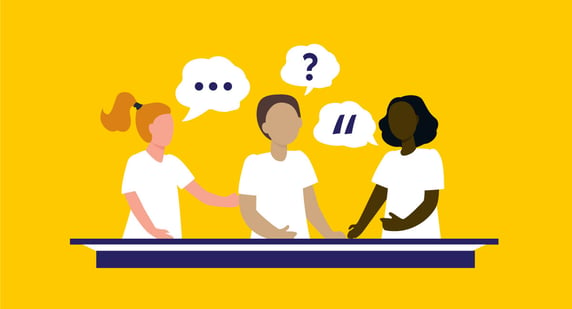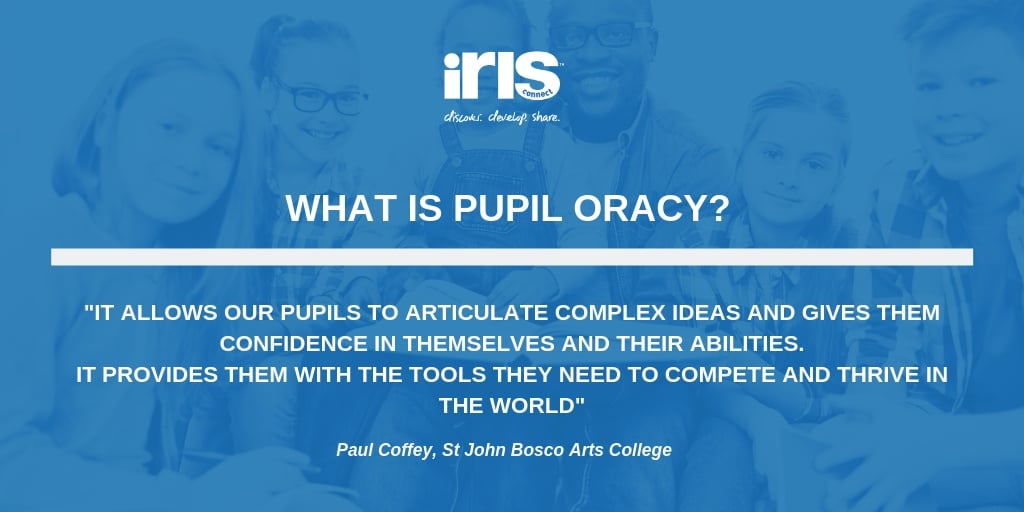 Is great dialogue taking place in your classroom and across your school?
Is great dialogue taking place in your classroom and across your school?
It’s well worth taking the time to reflect on this given the robust evidence that dialogic teaching (more broadly known as classroom talk) is key to improving formative assessment of pupils.
Research shows that there is a direct relationship between dialogic teaching and improved individual and collective academic outcomes. A report recently published by the Education Endowment Foundation (EEF) shows that spending more class time on meaningful dialogue that encourages pupils to reason, discuss, speculate, argue and explain, rather than simply give the expected answers can boost primary pupils’ Maths, Science and English results.
What is dialogic talk?
Dialogue means being able to articulate ideas seen from someone else’s perspective; it is characterised by chains of (primarily open) questions and answers; it may be sustained over the course of a single lesson or across lessons; and it builds on the idea of ‘exploratory talk’, where learners construct shared knowledge and are willing to change their minds and critique their own ideas (Prof. Neil Mercer, 2000).
So you can see that dialogue is talk with a very distinct character and purpose, designed to enable people to ‘interthink’ (Mercer, 2000; Littleton and Mercer, 2013) and come to an understanding of one another’s knowledge and perspectives. Thus, classroom dialogue might be thought of as collective, reciprocal, supportive, cumulative and purposeful.
What does healthy dialogic talk look like in the classroom?
- Children share a common goal or purpose
- Children allow each other to speak
- Children ask questions in order to understand better
- Children paraphrase or reflect back each other’s words
- Children are prepared to express uncertainty or tentativeness
- Children try to make their own point as clearly as possible
- Children explore differences of opinion
- Children give arguments to support their ideas
How to recognise dialogic teaching
Dialogue is more than ‘just talk’. It involves teachers and learners building on each other’s ideas, posing questions and constructing interpretations together.
“…dialogic teaching is as much about the teacher as the learner, and relates to teaching across the curriculum.” - Robin Alexander
A great dialogic teacher sees pupils as partners in the learning process, not just passive recipients of knowledge (Swaffield, 2011). When observing effective dialogic teaching you might expect to hear:
- Questions being used that support thinking
- Pupils being encouraged to elaborate or add detail
- Both teachers and pupils challenging the thinking of class members
- Pupils being asked to give reasons, justify what they assert and speculate
- People negotiating their position and changing their mind
How to encourage dialogue as a teacher
30 years of research shows that teachers primarily use classroom talk to give information, check understanding and maintain control. All of these are vital, however the evidence indicates that teachers can often dominate classroom interaction.
Key ways you can help improve the quality of interactions with your pupils include:
- The way you ask questions
- How you respond to pupils
- Your ‘wait time’ after asking a question
- How you respond to an incorrect answer (you could take the question around the class to tease out understanding rather than providing a correction)
You should also think beyond the dominant purposes of providing information and checking understanding.
Reflect on whether you use talk for such purposes as:
- Linking present activities to past experience
- Setting up future activities
- Relating existing ideas to new educational frames of meaning
- Modelling educated ways of using language
These might be thought of as higher order uses of talk, and the last one in particular has strong associations with the kinds of interactions that might happen during effective dialogue.
Professor Neil Mercer explains:
“We know enough [from the research] to say you should strive for a balance between authoritative presentation and genuine dialogue. And that the proportion of instructive talk and dialogue should be determined by what you want to achieve, not by your personality. A teacher may be more suited to one of those approaches, but they need both and it needs to fit the objective at that time.
There is tendency to think of oracy as speech-making or taking part in debates, but we actually mean the full range of spoken language skills, which would include working in a team, helping someone else learn something, listening sensitively to someone so you can help them, and so on. Children will differ in these skills. Some may be excellent making speeches but not skilled in a group situation – they may not listen to anyone else at all. While another student may be the opposite.”
To hear more from Mercer, listen to his podcast with the TES where he talks at length about the research around teacher and student talk and about strategies that teachers need to implement in order to improve both their own spoken language skills and those of their students.
Understanding pupil oracy
Oracy means that pupils are able to break down complex tasks; create and then implement possible solutions, and then convince others of them. It allows our pupils to articulate complex ideas and gives them confidence in themselves and their abilities. It provides them with the tools they need to compete and thrive in the world. (Paul Coffey, St John Bosco Arts College)

Why is pupil oracy important?
“Erm… like… erm… yeah… erm… sort of… you know what I mean…”
How often do we hear that in our classrooms?
We hear it from pupils that are struggling with a new concept, but are unable to articulate themselves. Sometimes we hear it from pupils who may know what they are doing, but lack the communication skills to explain it.
Oracy is not just for English lessons. Good oracy is so important in all of our subjects.
Why do we need to support pupil oracy?
Voice 21 stress that children from disadvantaged backgrounds are more likely to suffer from communication difficulties, and are afforded the least opportunity to develop the confidence and abilities in speaking that will enable them to compete with their more socioeconomically advantaged peers. Studies suggest that the average student in a secondary school in a deprived area speaks (as part of the formal part of a class) only four words a lesson - the equivalent of three hours across the whole of their time in school.
"Spoken language enables us to do much more than share information - it enables us to think together. But as teachers do we always use it to the best advantage? And do we give enough attention to enabling children to use language as a tool for learning and problem-solving?" - Neil Mercer.
How you can support pupil oracy
One way is to provide students with a basic language framework or model prompts to help them better articulate their thinking when discussing things as a class or in groups.
Sentences to add on to what someone else has said:
“Building on what _____ said about _____, I think ……”
“I agree with _____ because……”
Sentences to disagree with what someone has said:
“I politely disagree with _____ because …...”
“I see why you might say _____, but I think ……”
Sentences to ask for more information:
“Can you talk more about your thinking please?”
“What made you think of that?”
Using video for oracy development
Paul Coffey from St John Bosco Arts College discusses how they've used IRIS Connect for oracy development:
As we look to develop oracy with our pupils, IRIS Connect is once again proving to be an invaluable tool.
Our school Teaching and Learning team have split into departmental groups to explore whether having increased oracy skills can help pupils to tackle complex, multi-step problems.
To start with, selected classes were recorded while they explained how they would answer a given problem and baselines were taken. Then over the course of several weeks, the classes received specific ‘oracy lessons’ and were encouraged to use the techniques at every possibility. The class were recorded again upon the conclusion of the trial.
The use of IRIS Connect has made it incredibly simple to track how the pupils are progressing over time. Mr Steele, one of our math teachers has used the Forms tool to great effect, enabling us to easily record when and how, pupils are using specific language. We are in the process of comparing this data with control classes, and the results are already amazing to see. Pupils who have taken part are speaking in a more structured way, with a greater confidence and understanding of the topics they have been taught.
Thanks to IRIS Connect, we have actual lesson footage of the process which we can now use to provide examples for other staff. The IRIS Connect Forms have also given us clear, measurable quantitative data, which we can use to measure against success criteria.
On top of all this, we’re in the process of creating a new IRIS Connect Group to present examples of the research, our planning process, edited clips of footage, and all of the forms that were used. Having everything in one place will make it easier to share with wider staff and form a starting point for the new trials that will take place in the new academic year.
It’s going to be an exciting few months!
Ready to take this to the next level?
If you enjoyed the above and are keen to further improve your dialogic skills, try recording your classroom practice on video and then watch it back for effective reflection. You may even want to share this video with a peer or mentor to gain valuable feedback.




Leave a comment:
Get blog notifications
Keep up to date with our latest professional learning blogs.